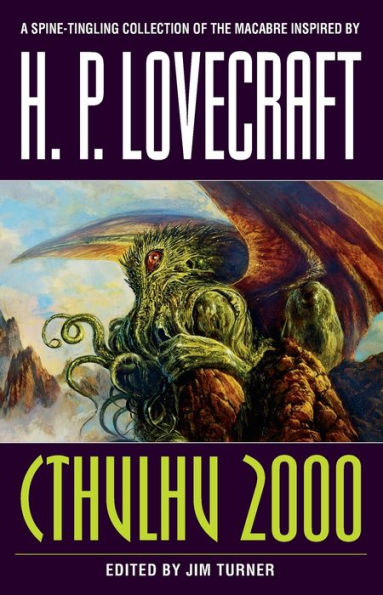Cthulhu 2000: Stories
A host of horror and fantasy’s top authors captures the spirit of supreme supernatural storyteller H. P. Lovecraft with eighteen chilling contemporary tales that would have made the master proud.
“The Barrens” by F. Paul Wilson: In a tangled wilderness, unearthly lights lead the way to a world no human was meant to see.
“His Mouth Will Taste of Wormwood” by Poppy Z. Brite: Two dabblers in black magic encounter a maestro of evil enchantment.
“On the Slab” by Harlan Ellison: The corpse of a one-eyed giant brings untold fortune—and unspeakable fear—to whoever possesses it.
“Pickman’s Modem” by Lawrence Watt-Evans: Horror is a keystroke away when an ancient evil lurks in modern technology.
PLUS FOURTEEN MORE BLOOD-CURDLING STORIES
“Shaft Number 247” by Basil Copper
“The Adder” by Fred Chappell
“Fat Face” by Michael Shea
“The Big Fish” by Kim Newman
“I Had Vacantly Crumpled It into My Pocket . . . But by God, Eliot, It Was a Photograph from Life!” by Joanna Russ
“H.P.L.” by Gahan Wilson
“The Unthinkable” by Bruce Sterling
“Black Man with a Horn” by T. E. D. Klein
“Love’s Eldritch Ichor” by Esther M. Friesner
“The Last Feast of Harlequin” by Thomas Ligotti
“The Shadow on the Doorstep” by James P. Blaylock
“Lord of the Land” by Gene Wolfe
“The Faces at Pine Dunes” by Ramsey Campbell
“24 Views of Mt. Fuji, by Hokusai” by Roger Zelazny
1105440312
“The Barrens” by F. Paul Wilson: In a tangled wilderness, unearthly lights lead the way to a world no human was meant to see.
“His Mouth Will Taste of Wormwood” by Poppy Z. Brite: Two dabblers in black magic encounter a maestro of evil enchantment.
“On the Slab” by Harlan Ellison: The corpse of a one-eyed giant brings untold fortune—and unspeakable fear—to whoever possesses it.
“Pickman’s Modem” by Lawrence Watt-Evans: Horror is a keystroke away when an ancient evil lurks in modern technology.
PLUS FOURTEEN MORE BLOOD-CURDLING STORIES
“Shaft Number 247” by Basil Copper
“The Adder” by Fred Chappell
“Fat Face” by Michael Shea
“The Big Fish” by Kim Newman
“I Had Vacantly Crumpled It into My Pocket . . . But by God, Eliot, It Was a Photograph from Life!” by Joanna Russ
“H.P.L.” by Gahan Wilson
“The Unthinkable” by Bruce Sterling
“Black Man with a Horn” by T. E. D. Klein
“Love’s Eldritch Ichor” by Esther M. Friesner
“The Last Feast of Harlequin” by Thomas Ligotti
“The Shadow on the Doorstep” by James P. Blaylock
“Lord of the Land” by Gene Wolfe
“The Faces at Pine Dunes” by Ramsey Campbell
“24 Views of Mt. Fuji, by Hokusai” by Roger Zelazny
Cthulhu 2000: Stories
A host of horror and fantasy’s top authors captures the spirit of supreme supernatural storyteller H. P. Lovecraft with eighteen chilling contemporary tales that would have made the master proud.
“The Barrens” by F. Paul Wilson: In a tangled wilderness, unearthly lights lead the way to a world no human was meant to see.
“His Mouth Will Taste of Wormwood” by Poppy Z. Brite: Two dabblers in black magic encounter a maestro of evil enchantment.
“On the Slab” by Harlan Ellison: The corpse of a one-eyed giant brings untold fortune—and unspeakable fear—to whoever possesses it.
“Pickman’s Modem” by Lawrence Watt-Evans: Horror is a keystroke away when an ancient evil lurks in modern technology.
PLUS FOURTEEN MORE BLOOD-CURDLING STORIES
“Shaft Number 247” by Basil Copper
“The Adder” by Fred Chappell
“Fat Face” by Michael Shea
“The Big Fish” by Kim Newman
“I Had Vacantly Crumpled It into My Pocket . . . But by God, Eliot, It Was a Photograph from Life!” by Joanna Russ
“H.P.L.” by Gahan Wilson
“The Unthinkable” by Bruce Sterling
“Black Man with a Horn” by T. E. D. Klein
“Love’s Eldritch Ichor” by Esther M. Friesner
“The Last Feast of Harlequin” by Thomas Ligotti
“The Shadow on the Doorstep” by James P. Blaylock
“Lord of the Land” by Gene Wolfe
“The Faces at Pine Dunes” by Ramsey Campbell
“24 Views of Mt. Fuji, by Hokusai” by Roger Zelazny
“The Barrens” by F. Paul Wilson: In a tangled wilderness, unearthly lights lead the way to a world no human was meant to see.
“His Mouth Will Taste of Wormwood” by Poppy Z. Brite: Two dabblers in black magic encounter a maestro of evil enchantment.
“On the Slab” by Harlan Ellison: The corpse of a one-eyed giant brings untold fortune—and unspeakable fear—to whoever possesses it.
“Pickman’s Modem” by Lawrence Watt-Evans: Horror is a keystroke away when an ancient evil lurks in modern technology.
PLUS FOURTEEN MORE BLOOD-CURDLING STORIES
“Shaft Number 247” by Basil Copper
“The Adder” by Fred Chappell
“Fat Face” by Michael Shea
“The Big Fish” by Kim Newman
“I Had Vacantly Crumpled It into My Pocket . . . But by God, Eliot, It Was a Photograph from Life!” by Joanna Russ
“H.P.L.” by Gahan Wilson
“The Unthinkable” by Bruce Sterling
“Black Man with a Horn” by T. E. D. Klein
“Love’s Eldritch Ichor” by Esther M. Friesner
“The Last Feast of Harlequin” by Thomas Ligotti
“The Shadow on the Doorstep” by James P. Blaylock
“Lord of the Land” by Gene Wolfe
“The Faces at Pine Dunes” by Ramsey Campbell
“24 Views of Mt. Fuji, by Hokusai” by Roger Zelazny
20.0
In Stock
5
1

Cthulhu 2000: Stories
416
Cthulhu 2000: Stories
416
20.0
In Stock

Product Details
| ISBN-13: | 9780345422033 |
|---|---|
| Publisher: | Random House Worlds |
| Publication date: | 05/25/1999 |
| Pages: | 416 |
| Product dimensions: | 5.20(w) x 8.15(h) x 0.90(d) |
About the Author

From the B&N Reads Blog
